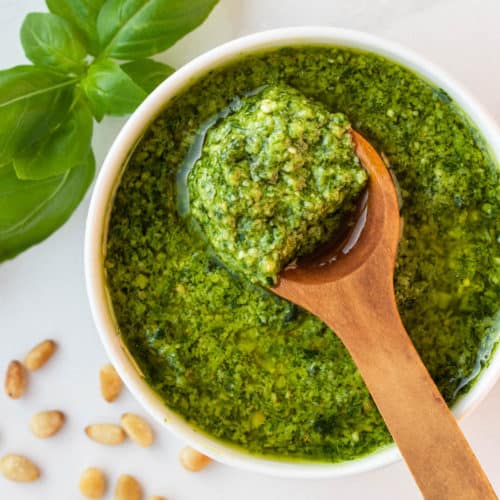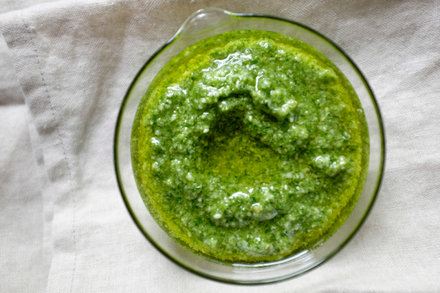Introduction
Cats are prone to hovering around your food as you eat, especially if it’s a delicious pasta dish like pesto. Pesto, on the other hand, has a lot of components, and it might be tempting to feed it to your cat. I mean, what’s the harm? Pesto, on the other hand, may be more dangerous to your cat than you know. Is pesto safe for cats to eat?
In a sentence, cats are unable to consume pesto as pesto contains spices, olive oil, milk, and cheeses, all of which can cause vomiting and cramping in cats. Garlic is poisonous to cats, therefore pesto contains a lot of it.
Pesto is a delicious sauce that several families like. It’s tempting to share it with cats because it’s a common commodity among humans. Pesto sauces, on the other hand, include components that are poisonous to cats, the most deadly of which being garlic. As an outcome, even a small amount of pesto might harm your cat.
Pesto can be harmful to your cat’s health even if just a tiny amount is consumed. The high garlic content is to blame for a lot of this. We’ll go through how each of these components might harm your cat and why you should be cautious about giving them pesto.
Is Basil Pesto Safe for Cats to Eat?
Yes. Cats are not poisoned by basil pesto. Pesto enhances the natural aromas and tastes of meals. Cats are finicky eaters, so adding basil pesto to their diet can help them eat more.
If you’re having trouble feeding a cat who refuses to eat, it’s time to try this natural herb pesto. After eating, it has no negative effects on the feline.
Ironically, basil pesto has a little nutritional benefit for cats, but it is an excellent stimulant for those cats who are fussy about what they eat.
Is Pesto Harmful to Cats?

Pesto is toxic to cats. The most serious problem with pesto is the sauce itself. Even in tiny doses, several of the chemicals are harmful to cats. The majority of pesto sauces are rich in salt and garlic.
Your cat may not only be affected by the garlic’s toxicity but it may also be affected by salt poisoning.
What Will Happen If Your Cat Consumes Pesto?
If your cat eats a lot of pesto, he or she will become quite unwell. They may most likely experience stomach difficulties and vomiting as a combination of the components in pesto, such as garlic and cheese.
The severity is determined by how much pesto your cat consumes. If they consume a full bowl of pesto, for example, you should be on the alert for serious health problems. The majority of this is due to the problems that garlic will create.
Pesto is rich in salt and contains a lot of spices. While the majority of the spices, such as basil, would not harm your cat, the salt can.
Salt is OK for cats, however too much salt can cause salt sickness. Dehydration and excessive fluid buildup are two symptoms of salt toxicity in cats. Additionally, your cat will vomit and have trouble walking.
Pesto’s other components, such as olive oil and pine nuts, are safe for cats. Olive oil offers certain advantages for cats, such as making their coats shinier. It’s also something that some cat owners use to prevent hairballs. Oil, on the other hand, is still fat, and cats should only consume it in moderation.
Pine nuts aren’t harmful to cats, and they’re included in a lot of pesto recipes. They, like the rest of the components, should be consumed in moderation.
Fat can only be digested to a limited extent by cats. Because pine nuts contain fat, they mustn’t eat too many of them. Each cat is unique, and some may have nut allergies. Cats with this allergy are at risk of developing anaphylaxis.
Pesto contains Garlic

Garlic is the most important element in pesto. The sauce loses a lot of its excellent taste combination without it. Garlic, however, is harmful to cats as a whole. It can create significant health problems whether they consume the whole thing or just a clove.
When it comes to cats, garlic is roughly five times more poisonous than onions. It’s highly concentrated and contains more hazardous chemicals.
So, what is garlic’s effect on cats? Garlic, on the other hand, includes chemicals called disulfide and thiosulphate. Foods from the Allium family contain such chemicals. These are chemicals that cats can’t digest, and they’re the source of the toxicity.
When a cat consumes garlic, the following symptoms may occur:
- Damage to red blood cells.
- Anemia of the Heinz body.
- Hemolytic anemia is a kind of anemia that causes the cat’s body to break down.
What you can do if your cat accidentally eats pesto?
There are also some things you must undertake if your cat consumes or licks pesto sauce. The very first step would be to take the pesto dish out of the oven and count how much has been consumed. Then, keep an eye out for indications of lethargy, weakness, illness, vomiting, or other odd behaviors in your cat.
There are also some things you must undertake if your cat consumes or licks pesto sauce. The very first step would be to take the pesto dish out of the oven and count how much has been consumed. Then, keep an eye out for indications of lethargy, weakness, illness, vomiting, or other odd behaviors in your cat. It’s crucial to highlight that many of the difficulties will not show for several hours, if not days. If you’re not sure what’s wrong with your cat, you should take it to the doctor immediately soon. Your vet can do tests to check if your cat has salt or garlic poisoning as a reaction to the pesto.
The much more effective approach you can do, in general, is to keep your cat from eating pesto in the first place. Make sure any pesto jars are firmly covered and kept in a location where your cat won’t be able to get to them. Also, make sure that your cat’s dishes are clean and not left out for him to lick.
